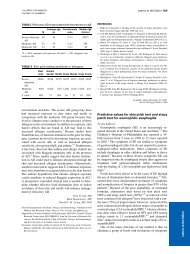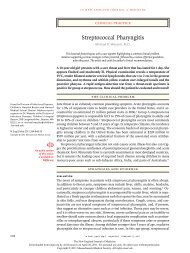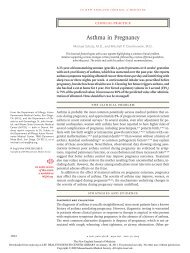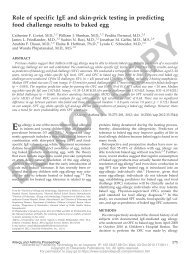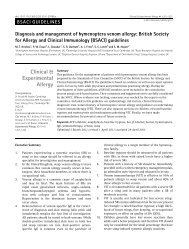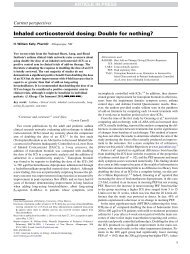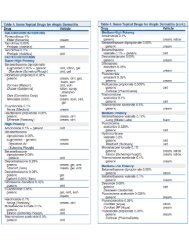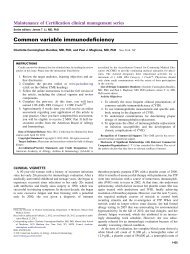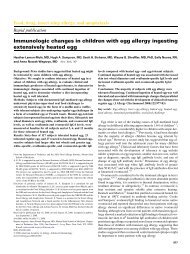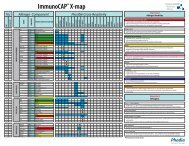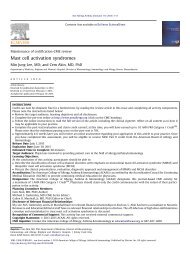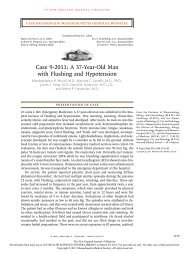Diagnosis and management of oral allergy syndrome ... - AInotes
Diagnosis and management of oral allergy syndrome ... - AInotes
Diagnosis and management of oral allergy syndrome ... - AInotes
You also want an ePaper? Increase the reach of your titles
YUMPU automatically turns print PDFs into web optimized ePapers that Google loves.
<strong>management</strong> <strong>of</strong> PFAS <strong>and</strong> clinicians vary considerably in their practices [34-36].<br />
One study specifically addressed the diagnosis <strong>and</strong> <strong>management</strong> <strong>of</strong> PFAS by<br />
allergists across the United States, using a questionnaire mailed to 226 r<strong>and</strong>omlyselected<br />
specialists [34]. Responses were returned by 122 allergists <strong>and</strong> revealed<br />
an array <strong>of</strong> practices. Median estimates <strong>of</strong> the prevalence <strong>of</strong> OAS in patients with<br />
pollen <strong>allergy</strong> were 5 percent among children <strong>and</strong> 8 percent among adults, which is<br />
significantly lower than the prevalence reported in published series, suggesting<br />
underdiagnosis. Fifty-three percent <strong>of</strong> allergists recommended complete avoidance<br />
<strong>of</strong> causal foods to all patients, whereas 9 percent did not advocate any restrictions.<br />
Three percent always prescribed epinephrine for OAS, 30 percent never did, <strong>and</strong> 66<br />
percent did so on a case by case basis. (See 'Indications for epinephrine' below.)<br />
The approach presented in this topic review is based upon the author's practice<br />
experience.<br />
Food avoidance <strong>and</strong> patient education — Analogous to other forms <strong>of</strong> food<br />
<strong>allergy</strong>, dietary avoidance <strong>of</strong> the <strong>of</strong>fending food(s) is the mainstay <strong>of</strong> the<br />
<strong>management</strong>. Patients are instructed to avoid the specific raw fruits or vegetables<br />
or the nuts (roasted or raw) that have caused symptoms in the past. The purpose<br />
<strong>of</strong> avoidance is the prevention <strong>of</strong> future reactions; there are no studies reporting<br />
the impact <strong>of</strong> avoidance on the natural history <strong>of</strong> the condition.<br />
All patients with PFAS should be informed <strong>of</strong> the following [24,25]:<br />
There is a small, but definite risk for systemic reactions, which is estimated to<br />
be between 2 <strong>and</strong> 10 percent <strong>of</strong> patients with PFAS<br />
Severe reactions can occur upon the first ingestion <strong>of</strong> a food with crossreactive<br />
proteins<br />
Systemic reactions to previously tolerated foods can occur<br />
The natural history <strong>of</strong> PFAS is unknown<br />
Specific clinical scenarios — In our practice, further <strong>management</strong> is dictated<br />
primarily by the severity <strong>of</strong> the patient's reaction. The food that caused the reaction<br />
is also considered.<br />
Patients with isolated oropharyngeal reactions — In cases <strong>of</strong> PFAS with<br />
isolated oropharyngeal symptoms, testing for sensitization to <strong>and</strong> prophylactic<br />
avoidance <strong>of</strong> potentially cross-reactive foods is generally not pursued. The patient<br />
may be given a printed list <strong>of</strong> related foods <strong>and</strong> advised to avoid the raw forms <strong>of</strong><br />
any that cause symptoms (figure 1). Patients should be made aware that<br />
dehydrated forms <strong>of</strong> the food may be used in seasonings <strong>and</strong> can cause reactions<br />
(eg, patients allergic to raw celery may react to celery spice, which is dried <strong>and</strong>



